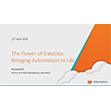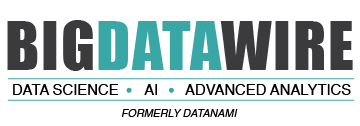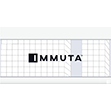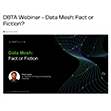

(TierneyMJ/Shutterstock)
Running a vector database in the cloud will be easier now that Pinecone is offering its vector database as a serverless offerings in Google Cloud and Microsoft Azure, to go along with an existing serverless product for AWS. The company also announced new enterprise features, including bulk import from object storage, among other features.
The advent of generative AI has supercharged the market for vector databases, which excel at storing, indexing, and storing vector embeddings. First used to bolster search with the power of nearest neighbor algorithms, companies today are scrambling to deploy vector databases as part of retrieval-augmented generation (RAG) setups that use pre-indexed vector embeddings to “ground” a large language model (LLM) with a customer’s own data.
Pinecone’s native vector database today is seeing a surge of interest from companies building GenAI applications, such as chatbots, question-answer systems, and co-pilots. As one of the older vector databases on the market (established 2019), Pinecone’s offering is well-regarded by analyst groups, and today’s announcements are likely to bolster that standing.
With serverless vector database offerings in all three major public clouds (it announced the general availability of its AWS serverless offering in May), Pinecone is positioned to capitalize on the current wave of investment in GenAI, much of which is occurring in the public cloud.
“Bringing Pinecone’s serverless vector database to Google Cloud Marketplace will help customers quickly deploy, manage, and grow the platform on Google Cloud’s trusted, global infrastructure,” Dai Vu, the managing director of marketplace and ISV go-to-market programs at Google Cloud, said in a blog today. “Pinecone customers can now easily build knowledgeable AI applications securely and at scale as they progress their digital transformation journeys.”
In addition to running its serverless offering on Microsoft Azure, Pinecone also integrates with the Azure OpenAI Service, which allows users to develop Gen AI applications faster by accessing OpenAI’s models and Pinecone serverless within the same Azure environment, Pinecone says. The company also notes that it has recently rolled out the first version of its .NET SDK, providing Azure developers the ability to build using native Microsoft languages.
In a typical serverless application, the customer is unburdened from worrying about the underlying server and the management thereof. But Pinecone’s serverless implementation goes beyond the typical setup, according to a blog post by Pinecone VP of R&D Ram Sriharsha earlier this year.
“Before Pinecone serverless, vector databases had to keep the entire index locally on the shards,” he writes in the January 16 blog post. “Such an architecture makes sense when you are running thousands of queries per second spread out across your entire corpus, but not for on-demand queries over large datasets where only a portion of your corpus is relevant for any query.”
“To drive order of magnitude cost savings to this workflow, we need to design vector databases that go beyond scatter-gather and likewise can effectively page portions of the index as needed from persistent, low-cost storage. That is, we need true decoupling of storage from compute for vector search.”
Pinecone also unveiled several new features in its serverless offerings today, new role-based access controls (RBAC); enhancements to backups; bulk import from object storage; and a new SDK.
The bulk import will lower the cost of the initial data load into Pinecone by 6x, the company says. That should help Pinecone customers ramp up their proofs of concepts (POCs) and production implementation.
“As an asynchronous, long-running operation, there’s no need for performance tuning or monitoring the status of your import operation,” Pinecone engineers Ben Esh and Gibbs Cullen write in the blog. “Just set it and forget it; Pinecone will handle the rest.”
Related Items:
Vectors: Coming to a Database Near You
Forrester Slices and Dices the Vector Database Market
April 18, 2025
- Snowflake and PostgreSQL Among Top Climbers in DB-Engines Rankings
- DataVisor Named a Leader in Forrester Wave for AML Solutions, Q2 2025
- GitLab Announces the General Availability of GitLab Duo with Amazon Q
- Anthropic Joins Palantir’s FedStart Program to Deploy Claude Application
- SnapLogic Announces Partnership with Glean to Transform the Agentic Enterprise
April 17, 2025
- Qlik Highlights Real-World Enterprise AI at Qlik Connect 2025 with Lenovo, Visa, and Reworld
- SnapLogic Ushers in the Era of Infinite AI Workforce for the Agentic Enterprise With AgentCreator 3.0
- Devo Highlights Analyst Overload in Push Toward Alertless SOC
- InfluxData Launches InfluxDB 3 Core and Enterprise for Real-Time Time Series Data
- Informatica and Carnegie Mellon University Partner to Drive Innovation in GenAI for Data Management
- SnapLogic Unveils Next-Gen API Management Solution to Power the Composable and Agentic Enterprise
- Monte Carlo Launches Observability Agents To Accelerate Data + AI Monitoring and Troubleshooting
- Berkeley Lab Spotlights Efficient Method for Faster Topological Data Analysis
- Vultr Recognized for Strength in Data Sovereignty and Security in 2025 Omdia Sovereign Cloud Report
April 16, 2025
- Fluidstack Selects VAST Data to Deliver Infrastructure to Accelerate Global Frontier AI Model Training
- Bauplan Launches with $7.5M in Seed to Bring AI & Data Infrastructure into Software Engineering
- AI is Driving a Surge in Data Budgets, According to New Report from dbt Labs
- Cloudera Survey Finds 96% of Enterprises Plan to Expand AI Agent Use in 2025
- Snowflake Research: 92% of Early Adopters See ROI from AI Investments
- MineOS Rolls Out AI Agent Purpose-Built for Privacy Compliance and Risk Management
- PayPal Feeds the DL Beast with Huge Vault of Fraud Data
- OpenTelemetry Is Too Complicated, VictoriaMetrics Says
- Will Model Context Protocol (MCP) Become the Standard for Agentic AI?
- Accelerating Agentic AI Productivity with Enterprise Frameworks
- When Will Large Vision Models Have Their ChatGPT Moment?
- Thriving in the Second Wave of Big Data Modernization
- What Benchmarks Say About Agentic AI’s Coding Potential
- Google Cloud Fleshes Out its Databases at Next 2025, with an Eye to AI
- Can We Learn to Live with AI Hallucinations?
- Google Cloud Preps for Agentic AI Era with ‘Ironwood’ TPU, New Models and Software
- More Features…
- Grafana’s Annual Report Uncovers Key Insights into the Future of Observability
- Google Cloud Cranks Up the Analytics at Next 2025
- Reporter’s Notebook: AI Hype and Glory at Nvidia GTC 2025
- New Intel CEO Lip-Bu Tan Promises Return to Engineering Innovation in Major Address
- AI One Emerges from Stealth to “End the Data Lake Era”
- Excessive Cloud Spending In the Spotlight
- Mathematica Helps Crack Zodiac Killer’s Code
- Big Growth Forecasted for Big Data
- New Benchmark for Real-Time Analytics Released by Timescale
- Big Data Career Notes for March 2025
- More News In Brief…
- Gartner Predicts 40% of Generative AI Solutions Will Be Multimodal By 2027
- MinIO: Introducing Model Context Protocol Server for MinIO AIStor
- Dataiku Achieves AWS Generative AI Competency
- AMD Powers New Google Cloud C4D and H4D VMs with 5th Gen EPYC CPUs
- Deloitte Survey Finds AI Use and Tech Investments Top Priorities for Private Companies in 2024
- Prophecy Introduces Fully Governed Self-Service Data Preparation for Databricks SQL
- Seagate Unveils IronWolf Pro 24TB Hard Drive for SMBs and Enterprises
- CData Launches Microsoft Fabric Integration Accelerator
- MLCommons Releases New MLPerf Inference v5.0 Benchmark Results
- Opsera Raises $20M to Expand AI-Driven DevOps Platform
- More This Just In…



























